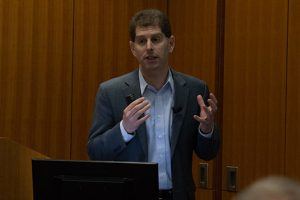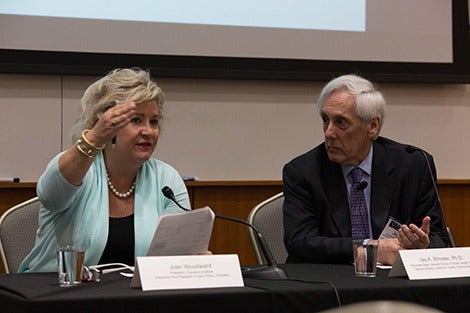May 2, 2018—A panel of distracted driving experts drew a packed audience of Harvard T.H. School of Public Health community members and guests for a discussion focused on how to solve a behavioral problem with no social stigma.
Texting Ourselves to Death, presented by the School’s Center for Health Communication and Travelers Institute, in collaboration with National Safety Council, Road to Zero Coalition, and MassBike, was held April 27, 2018 at the Joseph B. Martin Conference Center at Harvard Medical School.
While car fatalities have been going down since the 1970s, they saw the most significant two-year increase in more than 50 years between 2014 and 2016, Joan Woodward, president of Travelers Institute, noted in her opening remarks. She attributed this spike to two changes over the past decade: Drivers are logging more hours on the road, and they are increasingly distracted by their smart phones and vehicle systems.
Jay Winsten, who launched the successful Designated Driver campaign in the 1980s in the U.S., is now grappling with distracted driving. Winsten, Frank Stanton Director of the Center for Health Communication and associate dean for health communication, said that a key hurdle is that people don’t feel shame about their distracted driving habits. While they acknowledge that it is a serious problem, most believe that they are good enough at multitasking to get away with it. Rather than fight this misperception in a campaign, Winsten suggested promoting attentive driving—scanning for surprises from other drivers—particularly in riskier spots like urban intersections.

Safety features in cars are part of the problem. Increasing automation can make drivers overestimate their safety and feel that they can indulge in other activities. Researcher Bryan Reimer of MIT elicited gasps from the audience with videos of behind-the-wheel actions by drivers, including taking off a sweatshirt, putting in eye drops, and swiping on a tablet propped on the steering wheel. These are behaviors that would not have been acceptable even five years ago, Reimer said. “Driving has become the distraction.”
Reimer researches driver attention and the varying cognitive demands posed by distractions. In a study comparing crashes and near misses, he found that the moment in which a driver hears a ringtone or social media notification and decides to pick up is when they lose the most situational awareness and become vulnerable to crashing.
He and other speakers highlighted ways that technology may be able to help address distracted driving, such as having a light on the steering wheel that changes if drivers look away from the road for too long. Rafi Finegold, vice president of TrueMotion, described how his company’s app uses a smart phone’s sensors to tell if it is being used while driving, and scores users on their habits.
Change will also require a cultural shift. Speakers called for people to encourage their friends and family not to drive distracted, and for businesses to reduce pressure on employees to always be “on.”
Photos: Sarah Sholes
Read a Daily Beast op-ed co-authored by Bryan Reimer and Ted Courtney, instructor in the Department of Environmental Health at Harvard Chan School: Is Driving Now the Distraction?
